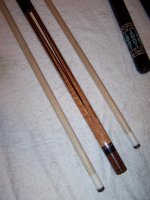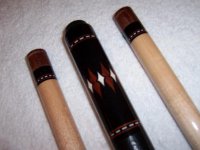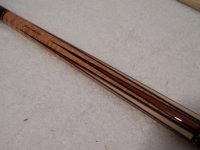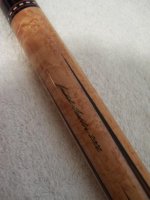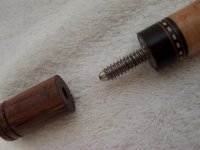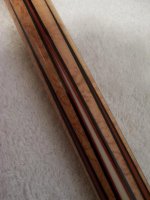You are using an out of date browser. It may not display this or other websites correctly.
You should upgrade or use an alternative browser.
You should upgrade or use an alternative browser.
20 pointer with ivory points
- Thread starter X Breaker
- Start date
lukeinva
Banned
max06 said:do the veneers count as points?
Thats the only way I could see 20 points!
Q Addiction
Registered
Judd's points
Judd does not make a cue with veneers. Those are all recut points that you see there, not veneers.
Judd does not make a cue with veneers. Those are all recut points that you see there, not veneers.
nipponbilliards said:Here is a Judd with a total of 20 points on the forearm. Everything white is ivory except the ferrule.
Awesome cue! Why does there have to be so many cuemakers that do incredible work?!
Thank you. That is correct. Judd never does veneers because he believes that it weakens the integrity of the cue--there is no glue line or any line for that matter at the tip of the points since the points are all re-cut. I had a Graig Peterson with recut points before--it was a 12 pointer but most people thought that it was a 4 pointer.Q Addiction said:Judd does not make a cue with veneers. Those are all recut points that you see there, not veneers.
I myself prefer recut points over veneers. I like the look without any glue line at the tip end. Besides, it amazes me how he could put so many points together and yet still make the cue look so clean and elegant.
This cue features a unique 5/16x14 flat face joint; unlike most of the star burst designs found on a Judd, this one features some very original diamond shape one-of-a-kind inlays.
The shafts hit very soild with very little deflection.
Thank you very much.
Richard
Veneered points
nipponbilliards said:Judd never does veneers because he believes that it weakens the integrity of the cue-
I think you might have a few people who would disagree with this statement.
SCCues
Damn I am just thinking about how much money I lost not selling all those Skips as 16 and 20 pointers..
Joe
Joe
Thank you. Regarding the venners vs re-cut point statement, I am just repeating what Judd told me--Judd never does venneer works and that is the reason he told me--he believed re-cut points are more solid. He also told me this cue has 20 points on the forarm.
I like recut points better myself but it is a personal preference--I like them because of the way they look. I am not here to judge what is good or bad or what is right or wrong; I just want to share pictures of a cue with viewers on this forum.
Thank you very much.
Richard
I like recut points better myself but it is a personal preference--I like them because of the way they look. I am not here to judge what is good or bad or what is right or wrong; I just want to share pictures of a cue with viewers on this forum.
Thank you very much.
Richard
Last edited:
classiccues said:Damn I am just thinking about how much money I lost not selling all those Skips as 16 and 20 pointers..
Joe
That is funny. Does Skip use re-cut points?
Thank you.
Richard
nipponbilliards said:That is funny. Does Skip use re-cut points?
Thank you.
Richard
Richard,
The effect is the same but the method is not. But I believe Bender started calling recuts "extra" points, before anyone else. Skips been doing these since 92 and still considers them 4 point cues, since they are modeled after the traditional short splice.
Joe
classiccues said:Richard,
The effect is the same but the method is not. But I believe Bender started calling recuts "extra" points, before anyone else. Skips been doing these since 92 and still considers them 4 point cues, since they are modeled after the traditional short splice.
Joe
Hi Joe:
Would you mind telling me how you or Skip would describe this cue. I certainly do not want anyone to think that I am misrepresenting this cue; however, according to the cue maker, in this case, Judd Fuller, this cue was sold as a 20 pointer. If I were to call it a 8 pointer, what should I call the recut points?
Thank you very much.
Regards,
Richard
nipponbilliards said:Hi Joe:
Would you mind telling me how you or Skip would describe this cue. I certainly do not want anyone to think that I am misrepresenting this cue; however, according to the cue maker, in this case, Judd Fuller, this cue was sold as a 20 pointer. If I were to call it a 8 pointer, what should I call the recut points?
Thank you very much.
Regards,
Richard
Richard,
If I had the cue and *not* knowing how the Judds classify their cues I would call it an 8 pointer, 4 hi and 4 lo, 4 lo points of ebony and burl?, 4 hi points of ebony, burl and ivory. BUT if the Judds want to call it 20 points I am ok with that too. I think its being done that way to make a definite distinction between the recut technique and the veneered points. But how would you classify it, if it wasn't a recut cue? 4 hi and 4 low points, 4 lo points of black veneer with a burl point, 4 hi points of black, brown veneer with an ivory point (prong). I think using the name of the woods sounds a bit more glamorous than just saying veneers of such and such....
examples of a traditional nature:
4 ebony points with black, red, black, and natural veneers OR
4 ebony points with ebony, bloodwood, ebony, and maple hardwood veneers..
4 rosewood points with black, orange, green and natural veneers OR
4 rosewood points with ebony, permanbuco, vera wood, and maple hardwood veneers...
The second example looks, and sounds more glamorous than the first...
Joe
classiccues said:Richard,
If I had the cue and *not* knowing how the Judds classify their cues I would call it an 8 pointer, 4 hi and 4 lo, 4 lo points of ebony and burl?, 4 hi points of ebony, burl and ivory. BUT if the Judds want to call it 20 points I am ok with that too. I think its being done that way to make a definite distinction between the recut technique and the veneered points. But how would you classify it, if it wasn't a recut cue? 4 hi and 4 low points, 4 lo points of black veneer with a burl point, 4 hi points of black, brown veneer with an ivory point (prong). I think using the name of the woods sounds a bit more glamorous than just saying veneers of such and such....
examples of a traditional nature:
4 ebony points with black, red, black, and natural veneers OR
4 ebony points with ebony, bloodwood, ebony, and maple hardwood veneers..
4 rosewood points with black, orange, green and natural veneers OR
4 rosewood points with ebony, permanbuco, vera wood, and maple hardwood veneers...
The second example looks, and sounds more glamorous than the first...
Joe
Hi Joe:
It is true. Using the names of the woods other than the color to name the veneers is certainly much better in the marketing application.
Thank you very much for the *pointers*...
Richard
nipponbilliards said:Hi Joe:
It is true. Using the names of the woods other than the color to name the veneers is certainly much better in the marketing application.
Thank you very much for the *pointers*...
Richard
Richard,
Glad to help, its a nice diversion for me from my quest to bring bottom dwellars to the surface.
Joe
nipponbilliards said:Thank you. That is correct. Judd never does veneers because he believes that it weakens ,,,,,,,,,,,,,,,,,,,,,,
The shafts hit very soild with very little deflection.
Thank you very much.
Richard
nippon....it's "craig" peterson.
i prefer veneers. i think their tougher to make WELL,,,, ie. hiding the mitered lines.
with today's machinery, i don't think it's difficult to splice point into point. all these cuemakers were machinists and dealt with 1/100000th" tolerances,,,accuracy is not a problem then. it would be a different story if cuemakers today were still building cues in the archaic manner that craig did. craig was, by far,THE BEST four point four veneer cuemaker in the business.
sycamore is what they use to make veneers, and though i don't know what the integral strength of sycamore is, i don't think it compromises the cue. i'd be interested to hear, though. if that were the case, tad, gutierrez, and other cuemakers who have great integrity would've stopped using sycamore veneers long ago. tad, in fact, used to be of the opinion that too much birdseye figuring was bad for maple since birdseye is essentially a diseased wood. so what's ok with him is ok with me.
Last edited:
classiccues said:Richard,
,,,,,,,,,,,,,,,,,,,,,,Judds want to call it 20 points I am ok with that too. I think its being done that way to make a definite distinction between the recut technique and the veneered points. But how would you classify it, if it wasn't a recut cue?
Joe
however they want to describe point into point cuemaking, it's all hype to me. hype as in,,,,,saying there's 40 pieces of ivory in the rings when all they did slice four wafers off a ring log.
i guess by definition, they have laid in points into points, though. BUT it's not going to dazzle me into thinking i'm getting something special,,,,,,,,,,,,AND PAYING FOR IT
